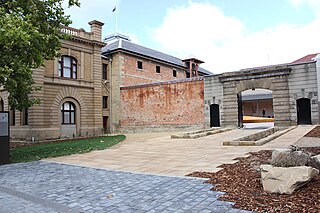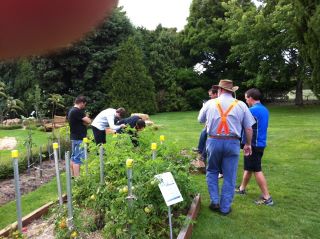
Kingston is a town on the outskirts of Hobart, Tasmania, Australia. Nestled 12 km south of the city between and around several hills, Kingston is the seat of the Kingborough Council, and today serves as the gateway between Hobart and the D'Entrecasteaux Channel region, which meets the Derwent River nearby. It is one of the fastest growing regions in Tasmania. The Kingston-Huntingfield statistical area had an estimated population of 11,200 in June 2012.

Circular Head Council is a local government body in Tasmania, covering the far north-west of the state mainland. Circular Head is classified as a rural local government area and has a population of 8,066, major towns and localities of the region include Arthur River, Marrawah and Stanley with Smithton the largest principal town.

Smithton is a town on the far north-west coast of Tasmania, Australia. It lies on the Bass Highway, 85 km north-west of Burnie. At the 2016 census, Smithton had a population of 3,881. Smithton is the administrative centre of the Circular Head Council.
The education system in Tasmania comprises two tertiary education institutions; the government run K-12 schooling system, and numerous independent private schools and colleges, most of which are controlled or sponsored by religious organisations. Public education in Tasmania is managed primarily by the State Government's Department of Education. The Department is responsible for all aspects of education in Tasmania including schooling, Adult Education, the State Library and TasTAFE, a vocational tertiary institution with many campuses around the state.

The Royal Tasmanian Botanical Gardens (RTBG), which cover an area of approximately 14 hectares, in Hobart located within the Queens Domain.

The Huon Valley, or simply the Huon is a valley and geographic area located in southern Tasmania, Australia. The largest town is Huonville, with other smaller towns spread across the area. It includes Australia's most southern permanent settlement at Southport. The Huon Valley Council area had a population of 15,140 in 2011. Famed for its apple growing, the Valley was first settled by British colonists in the 1820s; prior to settlement the Huon Valley area was inhabited by the Palawa people.
Tasmania's Relationships Act 2003 provided for registration and recognition of a type of registered partnership in two distinct categories: Significant Relationships and Caring Relationships. The same Act also amended 73 pieces of legislation to provide registered partners with nearly all of the rights offered to married couples within the state. Furthermore, since July 2009, these relationships are recognised at federal level, providing couples with almost all of the federal rights and benefits of marriage. The legislation came into effect on 1 January 2004. In September 2010, the Parliament of Tasmania approved legislation to recognize same-sex unions performed outside Tasmania as significant relationships.

The Tasmanian Museum and Art Gallery (TMAG) is a museum located in Hobart, Tasmania. The museum was established in 1846, by the Royal Society of Tasmania, the oldest Royal Society outside England. The TMAG receives 400,000 visitors annually.

Smooth Island, is a privately owned island with an area of 59.31 ha lying close to the south-eastern coast of Tasmania, Australia. The island is part of the Sloping Island Group situated in Norfolk Bay and surrounded by the Tasman and Forestier Peninsulas. The towns Dunalley and Murdunna are nearby. Smooth Island differs from other Tasmanian islands as it has an unencumbered freehold title down to the high-water mark.

Calvin Christian School is a coeducational, private Kindergarten to Year 12 Christian school located 12 kilometres south of Hobart, Tasmania in Kingston.

Woolmers Estate is a farming estate located in Longford, Tasmania, founded in 1817 by prominent grazier and member of parliament Thomas Archer. It consists of an 82ha property, including a two-part manor house, coach house, the National Rose Garden, extensive outbuildings and convict cottages and formal gardens. The main house consists of a brick nog weatherboard homestead, built in 1819, with an attached extensive addition in Italiate style, designed by William Archer and built in 1842-1843.

Gahnia grandis is a tussock-forming perennial plant found in southeastern mainland Australia and Tasmania.

Diplarrena moraea, commonly known as white iris, is a member of the iris family, Iridaceae. It occurs in Australian heathland and forest in New South Wales, Victoria and Tasmania.

Henry Hunter (1832–1892) was a prominent architect and civil servant in Tasmania and Queensland, Australia. He is best known for his work on churches. During his life was also at various times a state magistrate of Tasmania, a member of the Tasmanian State Board of Education, the Hobart Board of Health, a Commissioner for the New Norfolk Insane Asylum and President of the Queensland Institute of Architects.
Southern Christian College is an independent non-denominational Christian co-educational primary and secondary day school located in Kingston, Tasmania providing education from kinder to year 12, as well as providing pre-school services as Kingston Early Learning Centre. Southern Christian College was founded in 1986. Since 2014 it has been an International Baccalaureate world school, teaching the IB curriculum.
Cheshunt House is an Italianate mansion in the Meander Valley, Tasmania, 10 kilometers from Deloraine. It was designed and originally owned by politician, botanist and architect William Archer, started in 1851-52. It was purchased incomplete by the Bowman Brothers from William Archer in 1873, who completed it to his design in 1885. It fell into disrepair during the period of the World Wars and the Great Depression, before a restoration project was undertaken by the family in the 1970s. It is still owned by the Bowman family.
TasWater is Tasmania's water and sewage utility. It is responsible for providing drinking water across the state as well as collecting and treating sewage. It is owned by Tasmania's 29 Local Governments.
Tasmania is home to 'Australia’s largest cool temperate rainforests... Most of Tasmania’s rainforests occur in the North-West and throughout the North East highlands. Cool temperate rainforests typically have a heavy rainfall, cool climate, favor high altitudes and have a limited availability of light.
This article outlines the history of Smooth Island, popularly known as Garden Island, in Norfolk Bay, Tasmania. The names come from the island's gently undulating topography and lush vegetation in comparison with the stony mainland. It has been privately owned since 1864.
Kerry George Pink was a Tasmanian writer.











